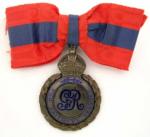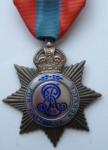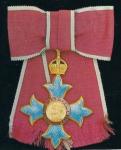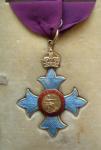-
Posts
276 -
Joined
-
Last visited
Content Type
Profiles
Forums
Blogs
Gallery
Events
Store
Everything posted by Odin Mk 3
-
Variants: Some EdVII issues have been noted with crown made as a separate piece which can be seen when viewing the medal from the reverse. The period this design was used is unclear but was probably used for some of the earlier unnamed EdVII stars. An example is shown below. I have compiled a complete register of all star / wreath shaped ISMs from the London Gazettes (total approx 10,800) and am able to quickly identify the LG date for each of these awards should forum members wish.
-
Naming: Although the awards were gazetted in the LG, the initial awards of the ISM were issued unnamed. Some of the earlier awards are found neatly named and it could be that some departments had their medals named before issue to the recipient. From LG 26th June 1908 all ISMs were issued named, engraved on the reverse with the recipient's first name, then further initials and surname. An example of the naming is shown below. The style of naming is similar for both late EdVII and GV medals.
-
Awards to Women: Initially the medals awarded to women were identical to those given to men but were worn from a bow shaped ribbon. Then the design was changed to a wreath design (in line with the Imperial Service Order for women) and this change probably occurred in 1908. As with the men's issue the centre was change in July 1911 to include the GV cipher. The wreath design was dropped in November 1919 when the small circular medal was adopted for both men and women. An example of a GV wreath design ISM is shown below.
-
George V Issues: With the death of Edward VII the design of the ISM was changed and medals awarded from LG 4th July 1911 had the centre bearing a new cipher for GV. This design was continued until LG 14th Nov 1919 when a new design of medal was adopted. The design of a George V Star is shown below. This example was awarded to Arthur S Jones who was a ship fitter at Pembroke Dockyard (a ship fitter worked on mechanical items outside of the engine / boiler rooms, on equipment such as winches).
-
Introduction: Following on from discussions in another thread I plan to cover the various types of Imperial Service Medals and give a guide to the timescales over which these types were issued. Hopefully that will help narrow the window when searching for the recipient in the London gazettes. This thread will cover the early issues; a second more detailed thread will cover the later (circular) medals. Edward VII Issues: The award of the Imperial Service Medal was first announced in LG 8th August 1902. It was 'tacked on' to the end of the entry covering the setting up of Imperial Service Order. The ISM was to be an award for those not eligible for the ISO (ie more junior employees) with the basic criteria of not less than twenty five years meritorious service in the United Kingdom or not less than sixteen years in a colony or protectorate recognised as having an unhealthy climate. The use of the term 'meritorious' is somewhat misleading as it implies a very high level of service. In more recent years the criteria has been interpreted as diligent service. According to the LG the design of the medal was to be the same as the ISO but made from silver. In fact the ISMs were made in bronze with a silvered centre. The initial awards appeared in LG 29th May 1903. The design of the Edward VII Star shaped awards is shown below. This particular example is to Alfred Killick who was a postman in Tunbridge Wells, Kent. The EdVII issues were continued up until LG 21st April 1911.
-

18 place ribbon bar possible?
Odin Mk 3 replied to paddywhack's topic in Great Britain: Orders, Gallantry, Campaign Medals
-

18 place ribbon bar possible?
Odin Mk 3 replied to paddywhack's topic in Great Britain: Orders, Gallantry, Campaign Medals
Going a bit off thread but for those not familiar with the awards here is a photo of an ISO, ISM (design used up to 1920), and more recent ISM. The QEII issue ISM shown was one made by a sub-contractor (Spink) around 1977 when the Royal Mint put the work out because of presssure of work to produce the 1977 Silver Jubilee Medals. The tale-tale sign is the way the suspender is pinned through the medal. Normally the QEII issues have the suspender pinned into the top of the rim of the medal by three (hidden) pins. It is possible to approximately date many ISMs because of design differences. I could cover this in much more detail if anyone is interested. -

18 place ribbon bar possible?
Odin Mk 3 replied to paddywhack's topic in Great Britain: Orders, Gallantry, Campaign Medals
Thanks for the correction - I was quoting from what JT had implied in what he had written in the article without having done any checks. I've looked at your list of possible 'suspects' and still feel that most are unlikely because of the later campaign medals (Korea and GSM 1962) and the relative dates you give for the ISO awards. Also the fact that the chap has the MSM suggests to me that he probably left as a Warrant Officer. Therefore he is unlikely to have been able to enter the civil service and climb to the necessary grade to be eligible for the ISO (old Grade 7 and above). Plus as I mentioned in an earlier post the ISO is usually given after a fair number of years service (ie towards the end of a person's career). The ISO is an unusual award, it's a pity that John Major decided to chop it for UK. I think that only Papau New Guinea has continued with the occasional award. -

18 place ribbon bar possible?
Odin Mk 3 replied to paddywhack's topic in Great Britain: Orders, Gallantry, Campaign Medals
No the ribbon is wider than the MM so it can't be a DCM. Both these ribbons are around 32mm wide, whereas the ISO / ISM is around 38mm wide. Also if you look carefully, apart from the missing 8 numeral from the Africa Star and the missing MID from the War Medal, there are two small thread pick marks on the MM suggesting that also had a rosette on it denoting a second award. I don't believe there were that many MM and bars for WWII. I have more doubts each time I look at the ribbons. -

18 place ribbon bar possible?
Odin Mk 3 replied to paddywhack's topic in Great Britain: Orders, Gallantry, Campaign Medals
I've been digging further in my old magazines etc. The OMRS published an article by John Tamplin in their Miscellany of Honours No 10 (published 1996). John had done a study of the ISO / ISM between 1902 and 1994 and produced a whole range of statistics including awards of other medals. Apparently there were 31 recipients of the MC with either the ISO (14) or ISM (17). Also there were 608 recipients of the MM with the ISM but none with the MM and ISO. So that would indicate that the ribbon bar is not correct unless possibly the ISM has been placed in the order where the ISO should be worn. I do have an ISM which has the man's name plus DCM and MM after his name. There is a man of that name in the London Gazettes with both post nominal letters suggesting the medal is correct. I found the man's DCM for WWI but couldn't find his MM so did he perhaps embelish his own awards with his colleagues and this was carried through when he was awarded his ISM? -

18 place ribbon bar possible?
Odin Mk 3 replied to paddywhack's topic in Great Britain: Orders, Gallantry, Campaign Medals
Also I have just remembered that the Order of St John (all grades) when worn as just a ribbon has a small maltese cross emblem on the ribbon. So the last medal would be the Service Medal for St John (without any extra long service bars). -

18 place ribbon bar possible?
Odin Mk 3 replied to paddywhack's topic in Great Britain: Orders, Gallantry, Campaign Medals
The correct order of wear is VC, GC, then Orders (inc ISO), Decorations (inc Order of St John), Gallantry Medals (inc MM), Campaign Medals, Polar Medals, Medals for valuable service (inc ISM), Jubilee and Coronation Medals, Long Service Medals (inc Service Medals of the Order of St John). So for that group to be correct the first medal would be the Imperial Service Order and the last would be the Service Medal of the Order of St John (=> the long service medal for St John Ambulance). The one thing that makes the whole group look somewhat suspect is the inclusion of the Meritorious Service Medal (next to last medal) as this would have (until recently) taken something like 27 years in the Army to be awarded that. Then you would be normally looking at 25 years plus for an ISO, giving a total of 52 years. Also as the ISO was only awarded to senior grades (principle and above) then you are looking at staff who normally retire at 60 - so I can't see where the recipient would have got enough time in to earn an ISO. Also the ISO was about the same level as an OBE so if someone did a really good job (and was well short of the 25 years) then they would be put up for an OBE rather than an ISO. The Jubilee Medals are also well spaced apart - 1935 and 1977 - 42 years. To achieve these two is not impossible but seems highly unlikely. I do have access to both medal rolls for the 1935 and 1977 Jubilees but don't have the inclination to do a comparison to see if one name appears in both lists. -
A couple of comments The submarines HMS Oppossum also served off Northern Ireland and I believe is the only submarine to qualify for the GSM 1962 bar Northern Ireland The South Atlantic Medals are named with the ship / submarine name for RN personnel. Those RN personnel who served on STUFTs (Ships Taken Up From Trade - eg SS Canberra) had their medals named with a Naval Party Number NP.... some examples are given: NP1710 - Canberra ... NP1830 - Uganda ... NP1840 - Atlantic Conveyer ... NP1850 - Norland ... NP 1980 - QE II
-

R.N ww1 war medal question
Odin Mk 3 replied to paddywhack's topic in Great Britain: Orders, Gallantry, Campaign Medals
On the question of the name of the ship being included on the medal for RN issues - this was the case for most Victorian campaigns. The only 20th Century Campaign Medals which show the ship were the Africa General Service Medal up to 1920 (RN mainly qualified for bars for Somaliland 1902-04, Somaliland 1908-10 and Somaliland 1920) and the Naval General Service Medal 1915 with the bar Persian Gulf 1909-1914. The practice stopped again up until the South Atlantic Medal in 1982 which has the ship name included but subsequent medals have not shown the ship. The Naval Long Service and Good Conduct Medal included the name of the ship for RN personnel and show the ship he served on when he qualified for his LS. Sadly this practice was stopped in around 1980. -

R.N ww1 war medal question
Odin Mk 3 replied to paddywhack's topic in Great Britain: Orders, Gallantry, Campaign Medals
No a Stoker 1st class was the equivalent of the AB rate (Sto 2nd class = Ordinary seaman) You had Leading Stokers = Leading Seaman equivalent Then PO and CPO Stokers who would have been in charge of a section -

Why erase the name on a Defence Medal?
Odin Mk 3 replied to Tony's topic in Great Britain: Orders, Gallantry, Campaign Medals
The question was raised over a renamed silver Defence Medal. Being pedantic the Canadian issue was in fact 0.800 fine silver and as such has a slightly different appearance to other silver medals such as the British War Medal. As far as I am aware the Canadians were the only ones that issued the Defence Medal in silver(ish). I also believe that these medals were issued unnamed, so if this medal was named (and then erased) it was named unofficially / privately. -

BRITISH C.B.E.
Odin Mk 3 replied to Mervyn Mitton's topic in Great Britain: Orders, Gallantry, Campaign Medals
I also forgot to mention that the ribbon widths are different - For the KBE and CBE the ribbon is 1 3/4 " (45mm), for the OBE and MBE it is 1 1/2 " (38mm) and for the British Empire Medal it is 1 1/4 " (32mm). As mentioned above for evening dress the CBE is worn from a narrower ribbon (minature ribbon) Being really obtuse, one aspect I am uncertain of is if a woman wears her CBE with other medals - the normal practice is to ditch the bow ribbon and use a conventional ribbon. So I suppose it might be possible for a woman to wear her CBE on the left breast from a normal (1.75") ribbon in front of other medals. However remember her CBE badge is different from the mens because of the top mounting ring being flat. -

BRITISH C.B.E.
Odin Mk 3 replied to Mervyn Mitton's topic in Great Britain: Orders, Gallantry, Campaign Medals
The ladies version of the CBE is worn as a breast badge but from a different (bow shaped) ribbon - see picture. Note that for the ladies version the ring is in the same plane as the medal and not at right angles as shown in the two examples above. -

BRITISH C.B.E.
Odin Mk 3 replied to Mervyn Mitton's topic in Great Britain: Orders, Gallantry, Campaign Medals
No there was no other ribbon with the medal when I got it. I'm slightly confused as to why there was a breast ribbon with yours - the CBE is only ever worn as a neck decoration and never on the left breast (although in evening dress it is worn on a much thinner ribbon). Also because the CBE ribbon ring is at right angles to the top of the medal it would never sit properly if you tried to wear it as a breast decoration. It could be the other ribbon was used by a collector just for display in cabinet or whatever because the normal longer ribbon would be too big. -

General Service Medal 1918 - 1962
Odin Mk 3 replied to a topic in Great Britain: Orders, Gallantry, Campaign Medals
Another GSM with a slightly unusual bar combination Iraq and Southern Desert Iraq The Southern Desert Iraq bar was primarily awarded to the RAF. This particular recipient served in the Machine Gun Corps in WWI (BWM & Victory Medal). He then served in Iraq with the King's Own Yorkshire Light Infantry (GSM and bar Iraq). He then transferred to the RAF (bar Southern Desert Iraq - which is loose on medal). He continued to serve with the RAF in India (India General Service Medal bar North West Frontier 1930-31). Note that unlike most other medals, the early issues of the GSM 1918 have no raised rim. This would normally help reduce contact damage from other medals and so if the GSM is worn extensively with other medals it tends to get more knocks and wear damage. This example is particularly badly worn. -

BRITISH C.B.E.
Odin Mk 3 replied to Mervyn Mitton's topic in Great Britain: Orders, Gallantry, Campaign Medals
Here is an example of the first type of CBE which was issued during the reign of King George V. The ribbon for awards to military personnel has an additional central thin red stripe. The card with instructions for wear is very similar to the one shown earlier in this thread. This particular medal was awarded in 1932 to Frederick Horton Wynne who was then H.M. Deputy Chief Inspector of Mines. He held the post of H.M. Chief Inspector of Mines from 1938 until his retirement in 1942 and died the following year. -

General Service Medal 1918 - 1962
Odin Mk 3 replied to a topic in Great Britain: Orders, Gallantry, Campaign Medals
-

General Service Medal 1918 - 1962
Odin Mk 3 replied to a topic in Great Britain: Orders, Gallantry, Campaign Medals
Something slightly different - a three bar GSM SE Asia 1945-46 Canal Zone Near East - part of a large group to a Major Indian Army, later British Army















